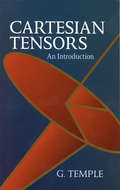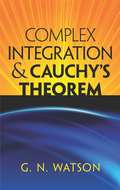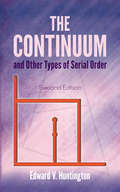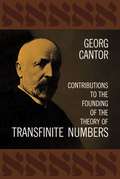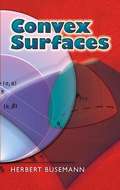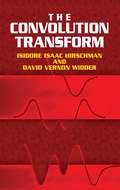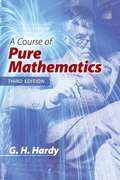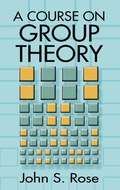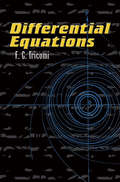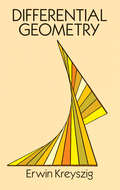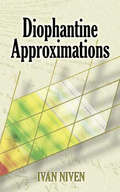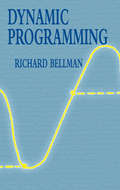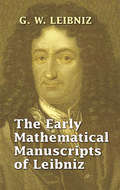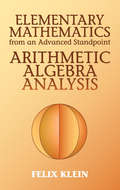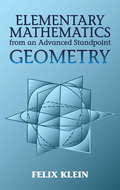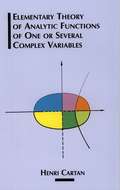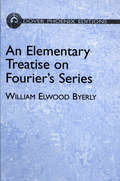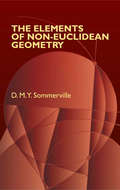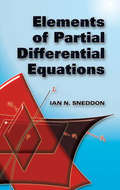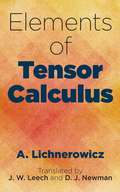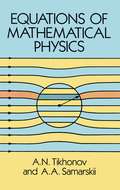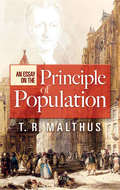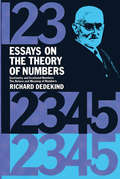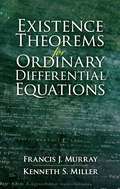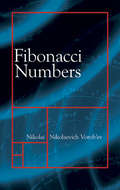- Table View
- List View
Cartesian Tensors: An Introduction (Dover Books on Mathematics)
by G. TempleThis undergraduate text provides an introduction to the theory of Cartesian tensors, defining tensors as multilinear functions of direction, and simplifying many theorems in a manner that lends unity to the subject. The author notes the importance of the analysis of the structure of tensors in terms of spectral sets of projection operators as part of the very substance of quantum theory. He therefore provides an elementary discussion of the subject, in addition to a view of isotropic tensors and spinor analysis within the confines of Euclidean space. The text concludes with an examination of tensors in orthogonal curvilinear coordinates. Numerous examples illustrate the general theory and indicate certain extensions and applications. 1960 edition.
Complex Integration and Cauchy's Theorem (Dover Books on Mathematics)
by G. N. WatsonThis brief monograph by one of the great mathematicians of the early twentieth century offers a single-volume compilation of propositions employed in proofs of Cauchy's theorem. Developing an arithmetical basis that avoids geometrical intuitions, Watson also provides a brief account of the various applications of the theorem to the evaluation of definite integrals.Author G. N. Watson begins by reviewing various propositions of Poincaré's Analysis Situs, upon which proof of the theorem's most general form depends. Subsequent chapters examine the calculus of residues, calculus optimization, the evaluation of definite integrals, and expansions in series. A historical summary concludes the text, which is supplemented by numerous challenging exercises.
The Continuum: and Other Types of Serial Order (Dover Books on Mathematics)
by Edward V. HuntingtonThis classic of mathematics presents the best systematic elementary account of the modern theory of the continuum as a type of serial order. Based on the Dedekind-Cantor ordinal theory, this text requires no knowledge of higher mathematics. Contents include a historical introduction and chapters on classes in general; simply ordered classes, or series; discrete series, especially the type of the natural numbers; dense series, especially the type of the rational numbers; continuous series, especially the type of the real numbers; continuous series of more than one dimension, with a note on multiply ordered classes; and well ordered series, with an introduction to Cantor's transfinite numbers. 1917 edition. 119 footnotes, mostly bibliographical.
Contributions to the Founding of the Theory of Transfinite Numbers (Dover Books on Mathematics)
by Georg CantorOne of the greatest mathematical classics of all time, this work established a new field of mathematics which was to be of incalculable importance in topology, number theory, analysis, theory of functions, etc., as well as in the entire field of modern logic. It is rare that a theory of such fundamental mathematical importance is expressed so simply and clearly: the reader with a good grasp of college mathematics will be able to understand most of the basic ideas and many of the proofs.Cantor first develops the elementary definitions and operations of cardinal and ordinal numbers and analyzes the concepts of "canlinality" and "ordinality." He covers such topics as the addition, multiplication, and exponentiation of cardinal numbers, the smallest transfinite cardinal number, the ordinal types of simply ordered aggregates, operations on ordinal types, the ordinal type of the linear continuum, and others. He then develops a theory of well-ordered aggregates, and investigates the ordinal numbers of well-ordered aggregates and the properties and extent of the transfinite ordinal numbers.An 82-page introduction by the eminent mathematical historian Philip E. B. Jourdain first sketches the background of Cantor's theory, discussing the contributions of such predecessors as Veicrstrass, Cauchy, Dedekind, Dirichlet, Riemann, Fourier, and Hankel; it then traces the development of the theory by summarizing and analyzing Cantor's earlier work. A bibliographical note provides information on further investigations in the theory of transfinite numbers by Frege, Peano, Whitehead, Russell, etc.
Convex Surfaces (Dover Books on Mathematics)
by Herbert BusemannIn this self-contained geometry text, the author describes the main results of convex surface theory, providing all definitions and precise theorems. The first half focuses on extrinsic geometry and applications of the Brunn-Minkowski theory. The second part examines intrinsic geometry and the realization of intrinsic metrics.Starting with a brief overview of notations and terminology, the text proceeds to convex curves, the theorems of Meusnier and Euler, extrinsic Gauss curvature, and the influence of the curvature on the local shape of a surface. A chapter on the Brunn-Minkowski theory and its applications is followed by examinations of intrinsic metrics, the metrics of convex hypersurfaces, geodesics, angles, triangulations, and the Gauss-Bonnet theorem. The final chapter explores the rigidity of convex polyhedra, the realization of polyhedral metrics, Weyl's problem, local realization of metrics with non-negative curvature, open and closed surfaces, and smoothness of realizations.
The Convolution Transform (Dover Books on Mathematics)
by David V. Widder Isidore Isaac HirschmanIn studies of general operators of the same nature, general convolution transforms are immediately encountered as the objects of inversion. The relation between differential operators and integral transforms is the basic theme of this work, which is geared toward upper-level undergraduates and graduate students. It may be read easily by anyone with a working knowledge of real and complex variable theory. Topics include the finite and non-finite kernels, variation diminishing transforms, asymptotic behavior of kernels, real inversion theory, representation theory, the Weierstrass transform, and complex inversion theory.
A Course of Pure Mathematics (Cambridge Mathematical Library)
by G. H. HardyOriginally published in 1908, this classic calculus text transformed university teaching and remains a must-read for all students of introductory mathematical analysis. Clear, rigorous explanations of the mathematics of analytical number theory and calculus cover single-variable calculus, sequences, number series, and properties of cos, sin, and log. Meticulous expositions detail the fundamental ideas underlying differential and integral calculus, the properties of infinite series, and the notion of limit. An expert in the fields of analysis and number theory, author G. H. Hardy taught for decades at both Cambridge and Oxford. A Course of Pure Mathematics is suitable for college and high school students and teachers of calculus as well as fans of pure math. Each chapter includes demanding problem sets that allow students to apply the principles directly, and four helpful Appendixes supplement the text.
A Course on Group Theory (Dover Books on Mathematics)
by John S. RoseThis textbook for advanced courses in group theory focuses on finite groups, with emphasis on the idea of group actions. Early chapters summarize presupposed facts, identify important themes, and establish the notation used throughout the book. Subsequent chapters explore the normal and arithmetical structures of groups as well as applications. Topics include the normal structure of groups: subgroups; homomorphisms and quotients; series; direct products and the structure of finitely generated Abelian groups; and group action on groups. Additional subjects range from the arithmetical structure of groups to classical notions of transfer and splitting by means of group action arguments. More than 675 exercises, many accompanied by hints, illustrate and extend the material.
Differential Equations (Dover Books on Mathematics)
by F. G. Tricomi Elizabeth A. McHargBased on his extensive experience as an educator, F. G. Tricomi wrote this practical and concise teaching text to offer a clear idea of the problems and methods of the theory of differential equations. The treatment is geared toward advanced undergraduates and graduate students and addresses only questions that can be resolved with rigor and simplicity.Starting with a consideration of the existence and uniqueness theorem, the text advances to the behavior of the characteristics of a first-order equation, boundary problems for second-order linear equations, asymptotic methods, and differential equations in the complex field. The author discusses only ordinary differential equations, excluding coverage of the methods of integration and stressing the importance of reading the properties of the integrals directly from the equations. An extensive bibliography and helpful indexes conclude the text.
Differential Geometry (Dover Books on Mathematics)
by Erwin KreyszigThis outstanding textbook by a distinguished mathematical scholar introduces the differential geometry of curves and surfaces in three-dimensional Euclidean space. The subject is presented in its simplest, most essential form, but with many explanatory details, figures and examples, and in a manner that conveys the geometric significance and theoretical and practical importance of the different concepts, methods and results involved.The first chapters of the book focus on the basic concepts and facts of analytic geometry, the theory of space curves, and the foundations of the theory of surfaces, including problems closely related to the first and second fundamental forms. The treatment of the theory of surfaces makes full use of the tensor calculus.The later chapters address geodesics, mappings of surfaces, special surfaces, and the absolute differential calculus and the displacement of Levi-Cività. Problems at the end of each section (with solutions at the end of the book) will help students meaningfully review the material presented, and familiarize themselves with the manner of reasoning in differential geometry.
Diophantine Approximations (Dover Books on Mathematics)
by Ivan NivenThis self-contained treatment originated as a series of lectures delivered to the Mathematical Association of America. It covers basic results on homogeneous approximation of real numbers; the analogue for complex numbers; basic results for nonhomogeneous approximation in the real case; the analogue for complex numbers; and fundamental properties of the multiples of an irrational number, for both the fractional and integral parts.The author refrains from the use of continuous fractions and includes basic results in the complex case, a feature often neglected in favor of the real number discussion. Each chapter concludes with a bibliographic account of closely related work; these sections also contain the sources from which the proofs are drawn.
Dynamic Programming
by Richard BellmanAn introduction to the mathematical theory of multistage decision processes, this text takes a "functional equation" approach to the discovery of optimum policies. Written by a leading developer of such policies, it presents a series of methods, uniqueness and existence theorems, and examples for solving the relevant equations. The text examines existence and uniqueness theorems, the optimal inventory equation, bottleneck problems in multistage production processes, a new formalism in the calculus of variation, strategies behind multistage games, and Markovian decision processes. Each chapter concludes with a problem set that Eric V. Denardo of Yale University, in his informative new introduction, calls "a rich lode of applications and research topics." 1957 edition. 37 figures.
The Early Mathematical Manuscripts of Leibniz
by G. W. Leibniz J. M. ChildThe manuscripts and correspondence of Leibniz possess a special interest: they are invaluable as aids to the study of their author's part in the invention and development of the infinitesimal calculus. In addition, the main ideas behind Leibniz's philosophical theories lay here, in his mathematical work.This volume consists of two sections. The first part features Leibniz's own accounts of his work, and the second section comprises critical and historical notes and essays. An informative Introduction leads to the "postscript" to Leibniz's 1703 letter to James Bernoulli, his "Historia et Origio Calculi Differentialis," and manuscripts of the period 1673-77. Essays by the distinguished scholar C. I. Gerhardt follow--Leibniz in London and Leibniz and Pascal, along with additional letters and manuscripts by Leibniz.
Elementary Mathematics from an Advanced Standpoint: Arithmetic, Algebra, Analysis
by Felix Klein"Makes the reader feel the inspiration that comes from listening to a great mathematician." -- Bulletin, American Mathematical SocietyA distinguished mathematician and educator enlivens abstract discussions of arithmetic, algebra, and analysis by means of graphical and geometrically perceptive methods. His three-part treatment begins with topics associated with arithmetic, including calculating with natural numbers, the first extension of the notion of number, special properties of integers, and complex numbers. Algebra-related subjects constitute the second part, which examines real equations with real unknowns and equations in the field of complex quantities. The final part explores elements of analysis, with discussions of logarithmic and exponential functions, the goniometric functions, and infinitesimal calculus. 1932 edition. 125 figures.
Elementary Mathematics from an Advanced Standpoint: Geometry (Dover Books on Mathematics #2)
by Felix Klein"Nothing comparable to it." — Mathematics Teacher. This comprehensive three-part treatment begins with a consideration of the simplest geometric manifolds: line-segment, area, and volume as relative magnitudes; the Grassmann determinant principle for the plane and the Grassmann principle for space; classification of the elementary configurations of space according to their behavior under transformation of rectangular coordinates; and derivative manifolds. The second section, on geometric transformations, examines affine and projective transformations; higher point transformations; transformations with change of space element; and the theory of the imaginary. The text concludes with a systematic discussion of geometry and its foundations. 1939 edition. 141 figures.
Elementary Theory of Analytic Functions of One or Several Complex Variables
by Henri CartanNoted mathematician offers basic treatment of theory of analytic functions of a complex variable, touching on analytic functions of several real or complex variables as well as the existence theorem for solutions of differential systems where data is analytic. Also included is a systematic, though elementary, exposition of theory of abstract complex manifolds of one complex dimension. Topics include power series in one variable, holomorphic functions, Cauchy’s integral, more. Exercises. 1973 edition.
An Elementary Treatise on Fourier's Series: and Spherical, Cylindrical, and Ellipsoidal Harmonics, with Applications to Problems in Mathematical
by William Elwood ByerlyOriginally published over a century ago, this work remains among the most useful and practical expositions of Fourier's series, and spherical, cylindrical, and ellipsoidal harmonics. The subsequent growth of science into a diverse range of specialties has enhanced the value of this classic, whose thorough, basic treatment presents material that is assumed in many other studies but seldom available in such concise form. The development of functions, series, and their differential equations receives detailed explanations, and throughout the text, theory is applied to practical problems, with the solutions fully worked out. In addition, 190 problems, many with hints, are included. 1893 edition. Appendix of 6 tables.
The Elements of Non-Euclidean Geometry
by D. M.Y. SommervilleThis volume became the standard text in the field almost immediately upon its original publication. Renowned for its lucid yet meticulous exposition, it can be appreciated by anyone familiar with high school algebra and geometry. Its arrangement follows the traditional pattern of plane and solid geometry, in which theorems are deduced from axioms and postulates. In this manner, students can follow the development of non-Euclidean geometry in strictly logical order, from a fundamental analysis of the concept of parallelism to such advanced topics as inversion and transformations.Topics include elementary hyperbolic geometry; elliptic geometry; analytic non-Euclidean geometry; representations of non-Euclidean geometry in Euclidean space; and space curvature and the philosophical implications of non-Euclidean geometry. Additional subjects encompass the theory of the radical axes, homothetic centers, and systems of circles; inversion, equations of transformation, and groups of motions; and the classification of conics.Although geared toward undergraduate students, this text treats such important and difficult topics as the relation between parataxy and parallelism, the absolute measure, the pseudosphere, Gauss’ proof of the defect-area theorem, geodesic representation, and other advanced subjects. In addition, its 136 problems offer practice in using the forms and methods developed in the text.
Elements of Partial Differential Equations
by Ian N. SneddonGeared toward students of applied rather than pure mathematics, this volume introduces elements of partial differential equations. Its focus is primarily upon finding solutions to particular equations rather than general theory.Topics include ordinary differential equations in more than two variables, partial differential equations of the first and second orders, Laplace's equation, the wave equation, and the diffusion equation. A helpful Appendix offers information on systems of surfaces, and solutions to the odd-numbered problems appear at the end of the book. Readers pursuing independent study will particularly appreciate the worked examples that appear throughout the text.
Elements of Tensor Calculus (Dover Books on Mathematics)
by A. Lichnerowicz D. J. Newman J. W. LeechThis classic introductory text, geared toward undergraduate students of mathematics, is the work of an internationally renowned authority on tensor calculus. The two-part treatment offers a rigorous presentation of tensor calculus as a development of vector analysis as well as discussions of the most important applications of tensor calculus.Starting with a chapter on vector spaces, Part I explores affine Euclidean point spaces, tensor algebra, curvilinear coordinates in Euclidean space, and Riemannian spaces. Part II examines the use of tensors in classical analytical dynamics and details the role of tensors in special relativity theory. The book concludes with a brief presentation of the field equations of general relativity theory.
Equations of Mathematical Physics
by A. A. Samarskii A. N. TikhonovMathematical physics plays an important role in the study of many physical processes -- hydrodynamics, elasticity, and electrodynamics, to name just a few. Because of the enormous range and variety of problems dealt with by mathematical physics, this thorough advanced undergraduate- or graduate-level text considers only those problems leading to partial differential equations. Contents:I. Classification of Partial Differential EquationsII. Evaluations of the Hyperbolic TypeIII. Equations of the Parabolic TypeIV. Equations of Elliptic TypeV. Wave Propagation in SpaceVI. Heat Conduction in SpaceVII. Equations of Elliptic Type (Continuation)The authors -- two well-known Russian mathematicians -- have focused on typical physical processes and the principal types of equations dealing with them. Special attention is paid throughout to mathematical formulation, rigorous solutions, and physical interpretation of the results obtained. Carefully chosen problems designed to promote technical skills are contained in each chapter, along with extremely useful appendixes that supply applications of solution methods described in the main text. At the end of the book, a helpful supplement discusses special functions, including spherical and cylindrical functions.
An Essay on the Principle of Population
by T. R. MalthusThe first major study of population size and its tremendous importance to the character and quality of society, this polemic examines the tendency of human numbers to outstrip their resources. Pivotal in establishing the field of demography, it remains crucial to understanding modern problems with food production and distribution.Anglican parson Thomas Robert Malthus wrote his famous essay in 1798 in response to speculations on social perfectibility aroused by the French Revolution. Because human powers of procreation so greatly exceed the production of food, Malthus explained, population will always exceed available resources, and many will inevitably live at the ragged edge of subsistence. His simple yet powerful argument — demonstrating that scarcity and inequality arise even in a society purged of all unjust laws and institutions — was highly controversial in its day. Many of Malthus' contemporaries despised him for dashing their hopes of social progress, and the grim logic of his "population principle" led Thomas Carlyle to dub economics "the dismal science." Today, Malthus' name is practically synonymous with active concern about demographic and ecological prospects, and his classic remains ever relevant to issues of social policy, theology, evolution, and the environment.
Essays on the Theory of Numbers (Dover Books on Mathematics)
by Richard DedekindThis volume contains the two most important essays on the logical foundations of the number system by the famous German mathematician J. W. R. Dedekind. The first presents Dedekind's theory of the irrational number-the Dedekind cut idea-perhaps the most famous of several such theories created in the 19th century to give a precise meaning to irrational numbers, which had been used on an intuitive basis since Greek times. This paper provided a purely arithmetic and perfectly rigorous foundation for the irrational numbers and thereby a rigorous meaning of continuity in analysis.The second essay is an attempt to give a logical basis for transfinite numbers and properties of the natural numbers. It examines the notion of natural numbers, the distinction between finite and transfinite (infinite) whole numbers, and the logical validity of the type of proof called mathematical or complete induction.The contents of these essays belong to the foundations of mathematics and will be welcomed by those who are prepared to look into the somewhat subtle meanings of the elements of our number system. As a major work of an important mathematician, the book deserves a place in the personal library of every practicing mathematician and every teacher and historian of mathematics. Authorized translations by "Vooster " V. Beman.
Existence Theorems for Ordinary Differential Equations (Dover Books on Mathematics)
by Kenneth S. Miller Francis J. MurrayTheorems stating the existence of an object—such as the solution to a problem or equation—are known as existence theorems. This text examines fundamental and general existence theorems, along with the Picard iterants, and applies them to properties of solutions and linear differential equations.The authors assume a basic knowledge of real function theory, and for certain specialized results, of elementary functions of a complex variable. They do not consider the elementary methods for solving certain special differential equations, nor advanced specialized topics; within these restrictions, they obtain a logically coherent discussion for students at a specific phase of their mathematical development. The treatment begins with a survey of fundamental existence theorems and advances to general existence and uniqueness theorems. Subsequent chapters explore the Picard iterants, properties of solutions, and linear differential equations.
Fibonacci Numbers (Dover Books on Mathematics)
by Nikolai Nikolaevich Vorob'EvFibonacci numbers date back to an 800-year-old problem concerning the number of offspring born in a single year to a pair of rabbits. This book offers the solution and explores the occurrence of Fibonacci numbers in number theory, continued fractions, and geometry. A discussion of the "golden section" rectangle, in which the lengths of the sides can be expressed as a ration of two successive Fibonacci numbers, draws upon attempts by ancient and medieval thinkers to base aesthetic and philosophical principles on the beauty of these figures. Recreational readers as well as students and teachers will appreciate this light and entertaining treatment of a classic puzzle.
